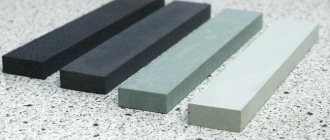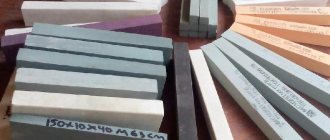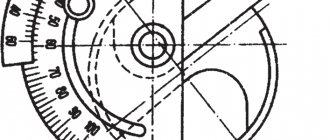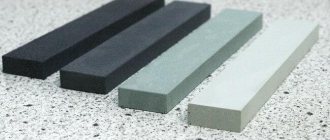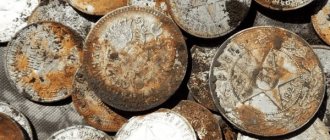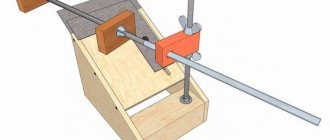Wheels for sharpening tools are not only abrasive (read about vulcanite wheels). Of course, most often these are the ones that are used on sandpapers, since they fulfill the owner’s requirements without any problems. Sharpening a kitchen knife or scissors is no problem. However, there are other types - diamond.
They are also suitable for sharpening home tools, but for a finer finish. It will not be possible to sharpen an ax with such a circle, its grain is too fine. So, diamond wheels are used for sharpening tools; they are used to sharpen hard alloys (brazing on drill bits for a hammer drill, brazing on drills and circular saws for a circular saw).
As you can see, the scope of application is quite large. The advantages of such circles are that they practically do not wear out, one circle lasts for a year or more (depending on the frequency of use). When I was a stone engraver, we used a diamond cup mounted on emery to sharpen pobedite cutters (to cut out patterns on granite) - it lasted for 3 years of use (and we sharpened cutters made of P18 steel every day).
Let's look at the classification of diamond wheels, how to choose the right one, and what to pay attention to. The first is the shape, there are 3 types - cup, plate and straight profile.
Diamond cup. Marking 12A245(deep)
In general, the markings of the wheels contain many numbers, including the width of the diamond layer and its thickness, and the fit (the diameter of the internal hole). The thicker the diamond layer, the more expensive the sharpening disc. For example, sharpening cup 12A245 150*40*10*3*32 125/100 - this means a cup with a diameter of 150 mm, depth 40 mm, thickness of the diamond layer - 10 mm, its thickness - 3 mm, fit - 32 mm (standard). 125/100 mm - diamond grain size (read below).
This thing is perfect for sharpening tools (soldering tips, cutters, knives, etc.).
Shallow plate. Marking 12A220
In appearance, the plate differs noticeably from the cup in depth; as a rule, the height is only 18 mm. In the other everything is standard, diamond grinding wheel 12A220 150*10*2*18*32 160/125 - plate with a diameter of 150 mm, width of the diamond layer 10 mm, thickness 2 mm, depth - 18 mm (shallow), fit 32 mm. Grain 165/100 is quite coarse compared to others.
Plates come in 150 mm and 125 mm diameters.
They are excellent for sharpening tools; moreover, they can be used to sharpen carbide tips on circular saws. In order to sharpen such tips, you will need a thin plate so that the edge can fit between the teeth.
Why a whetstone?
In order to restore lost sharpness to knives (or give it to them for the first time), there are many devices. There are hand-held sharpeners made up of several abrasive discs, and electric devices, even large sharpening machines that are used in enterprises.
For obvious reasons, you won’t keep bulky equipment at home. As for manual sharpeners, their big disadvantage is the inability to set the sharpening angle, as well as the fact that the blade runs along the working part, which leads to accelerated wear of the knife. In addition, such sharpening does not last long.
Unlike previous options, a sharpening stone (or whetstone) gives the owner of the knife a certain freedom of action, for example, choosing the angle at which the cutting edge will be processed.
If you reach a certain level of skill, then with the help of a set of sharpening stones you can bring the knife to the state that craftsmen demonstrate in the video: shaving, cutting hair on the fly, or cutting off the transparent layers from a tomato without holding it with your hands.
Grain
Circles are small, medium and large, however, the grain is indicated by 2 numbers at once through a fraction.
- 200/160 - the largest
- 165/100 - large
- 125/100 - average
- 100/80 - fine-grained
The largest diamond grain is used where it is necessary to remove a layer of metal noticeably. For example, to align the cutting part of a knife. Large ones are also used. Medium grain - for fine-tuning the cutting part, to give the ideal sharpness. Fine - for final finishing - suitable for sharpening knives as a blade.
Also in the marking you can see the value AC4. AS - synthetic diamond. Most often, such circles are made from it, so you shouldn’t bother too much.
Conclusion - “diamonds” are excellent for sharpening tools, most often they are hard alloys and hard tool steels (P18, P9, steel with cobalt R6M5K5 and others). In addition to this, you can sharpen knives and other household tools, although then it is better to take a larger grain (at least 165/100), otherwise if you buy a wheel with 100/80 grain for your home, you will not be able to sharpen anything on it, it is so fine , will only remove microns that are invisible to the eye.
Physical properties of abrasives
For thousands of years, people have used abrasives. They made and sharpened knives, spears, arrows, fishing tackle and hooks using sand and stone. Sandstone was the first. It contains quartz crystals. This mineral was a popular natural abrasive until other methods were discovered for processing metal. With the help of sandstone, humanity has learned to make various household items, weapons and work tools.
When it comes to abrasives, everyone understands the high hardness of the mineral. On the Mohs scale they are located at the top (from quartz to diamond). However, soft materials also perform the same function, for example, baking soda, seeds (fruit), even sponges are abrasives. We come across such items almost every day; they help in everyday life and household chores.
For many centuries, natural abrasives - diamond, flint, garnet, emery and others - were used to create grinding tools. They are still popular abrasives today that can help in manual polishing or finishing of knives, blades, etc.
Natural abrasives with beautiful names - bars made of Turkish or Belgian stone, washite or Arkansas, Thuringian slate. Diamond is also not ignored, as it does an excellent job on stone and glass.
2 Device for sharpening turning tools
Sharpening tools involves not only wheels, but also the use of additional devices - boring machines.
Jig boring machines bore, drill, countersink, cut internal and external threads, grind cylindrical surfaces and trim ends.
Tool sharpening machine
A distinctive feature of the machines is a horizontal (or vertical) spindle, which makes axial feed movements. The necessary tool is fixed into the spindle hole - a boring bar with a cutter, a reamer, a drill, a milling cutter, etc.
- horizontal boring;
- coordinate boring;
- diamond boring;
- vertical boring.
Specialized models of jig boring machines:
- Jig boring machine 2D450.
- Jig boring machine 2V440A.
- Jig boring machine 2431.
- Jig boring machine 2421.
2.1 Sharpening technology
- Main back surface.
- Auxiliary back surface.
- Front surface.
- The radius of curvature of the ring.
At the end, the sharpening angles are checked using a template.
Types of sharpening of cutters
To obtain an even and smooth edge, the tool must be constantly in motion along the grinding surface. With this kind of work, the circles will last longer.
The tool can be processed dry or with water. The flow of water must be sufficient and continuous. A dry tool should not be immersed in water, as this may cause destruction of the working edge.
- fine-grained whetstone (technical oil is also used);
- copper wheel (boron carbide paste and technical oil are also used).
Finishing can only be done on cutting tools (edge width up to 3mm).
2.2 Safety precautions
- Do not use grinding wheels whose operation is accompanied by beating.
- The tool rest should be securely fixed closer to the circle.
- Use a tool rest to support the cutter.
- Do not press the cutter too hard (uneven heating can cause cracks; under high pressure the wheel can quickly deteriorate).
- Do not sharpen without a protective guard.
- Wear safety glasses.
- The workplace must have local ventilation.
What characteristics are indicated on the grinding wheel?
- Abbreviation of the manufacturer.
- The material from which the abrasive wheel is made.
| Material | Name | Characteristics |
| 13A, 14A, 15A, 16A | electrocorundum normal | The color of the material is pink, red, brown. Quite soft, does not heat up during operation |
| 23A, 24A, 25A | electrocorundum white | Harder, but still brittle. High abrasive properties |
| 32A, 33A, 34A | chromium electrocorundum | High grinding performance |
| 37A | titanium electrocorundum | The main property is increased viscosity. Used when working with large removal thickness of the treated surface |
| 38A | electrocorundum zirconium | The highest strength among electrocorundums. Able to withstand strong pressure on the tool, especially when carrying out roughing work |
| 43A, 44A, 45A | monocorundum family | Very strong grains with sharp, protruding edges. Used for grinding hard alloys |
| 53С, 54С | black silicon carbide | High mechanical strength. Found application in the processing of cast iron, glass, and non-ferrous metals. Virtually no wear |
| 62С, 63С, 64С | green silicon carbide | Area of application: sharpening of carbide cutting tools, including pobedit tips. Ceramic polishing |
The grain size (roughness) of the abrasive material is in accordance with GOST R 52381-2005 or FEPA (ISO 8486) according to the European certification system. Marked within a very wide range. The finest grain F220 corresponds to a size of 50 microns. Average grain F46 – 400 microns. Large F4 is measured in millimeters.
The hardness of the grinding wheel according to GOST R 52587-2006, that is, the ability of the grain to be held together. Has mutually exclusive properties. Such a disk wears out less, but heats up the workpiece greatly, up to the so-called. "burns".
Soft - gentle on the material, but quickly loses its shape and requires frequent editing. Wheels are classified according to hardness using the Latin alphabet, in ascending order:
- F, G, H, I, J – soft
- K, L, M, N – medium
- O, P, Q, R, S – solid
- T, U, V, W, X, Y, Z – very hard
Structure of the material (density of the abrasive relative to the volume of the wheel). The higher the value, the lower the density and, accordingly, the heat dissipation. Not always indicated.
- 0, 1, 2, 3, 4 density 68-54%
- 5, 6, 7, 8 density 53-48%
- 9, 10, 11, 12 density 44-38%
- 13, 14 and more density 36-34% and less
Main types of ligament material. In fact, there are many more binding materials, but no more than three are used in the mass production of abrasive wheels.
- V – ceramic bond
- B – bakelite bond
- R – vulcanite bond
Geometric circle shape . For example: PP - straight profile, PVK - with a conical groove, ChK - cup conical. The circle shape is obvious, so this type of marking is not that significant.
The manufacturer can also indicate the geometric dimensions, where the diameter of the mounting hole is especially important, and the maximum rotation speed of the wheel.
About the types and types of creative circles in detail in this video
- How do you sharpen your knives? - I have diamond bars! - Ah, you probably don’t know that they are not suitable for every knife...
(From a conversation with a blacksmith)
Quickly correct the sharpening of a knife while hunting or fishing, or sharpen the cutting edge on a newly made or completely ruined knife - with the help of a diamond stone you can do this easily and simply. Only two conditions...
- You have chosen the right diamond stone for your tasks.
- And he mastered the basic techniques of straightening and sharpening on diamonds.
Let's talk about this. The article will not contain any complex terms and concepts, for example, “deposition of diamond abrasive powder on the steel surface of a bar using an epoxy compound” or “holding diamonds using electrolytically deposited nickel”)). No, I'm not talking about that today.
The purpose of this material is to teach you how to choose a diamond stone to suit your needs and use it if necessary.
And to make our conversation easier, watch the comic video that we specially filmed for this purpose. Yes, this video is about diamond bars.
VIDEO: Diamond bars. The main thing is not to get carried away))
Well, now let's continue. What is a “diamond block”? Typically, this is a plastic or aluminum base on which two metal plates are fixed, on which abrasive diamond grains are planted and held using chemical methods.
Read also: Earth drill for a hammer drill
Rice. 1 Structure of a double-sided diamond whetstone for sharpening and dressing knives
The great advantage of diamond whetstones is that even a “seasoned” whetstone that has seen dozens of knives remains absolutely flat. “What other advantages do these bars have?” you ask.
Diamond bars: advantages
- Diamond abrasive grains have sharper edges compared to other abrasives and do not change their shape during operation.
- Diamond stones are not brittle; they will not break under impact, like natural or artificial sharpening stones.
- Sharpening with diamond stones does not require special oil - just lightly moisten it with water.
- The diamond block will not become clogged when sharpening with particles of the knife being processed. To clean the bar, just rinse it in water and wipe dry with a rag or fiber.
- Diamond whetstones grind down steel very quickly. This allows you to preserve the working surface (length) of the bar for a longer time compared to ceramics or natural abrasives.
But don’t rush to run to the store or surf the Internet to buy a diamond stone. These bars have two disadvantages that may be important to you:
Diamond bars: disadvantages
- Effective grinding of knife steel during sharpening on diamond stones can lead to irreparable damage to the blade in inept hands.
- And the second drawback is the “price”. Yes, diamond stones are somewhat expensive compared to natural abrasives, since the technology for producing good (read branded) diamond stones is quite expensive. And prices usually start at 800 rubles (11/02/2016). Have you seen it cheaper? Avoid this block! After 5-10 sharpenings it will be bald - you’ll have to throw it away, but you don’t want that, do you?
We’ll fix your hands now)) – more on that below. And the second drawback, “price,” is more problematic to correct. Everything is in your hands here. Sorry for the pun.
Diamond bars: designation and marking
But first, let's learn how to choose a diamond stone. Have you seen their designation? Look: 2500/2000, 2000/1600, 1600/1250, 1250/1000, 1000/80, 800/630, 630/500, 500/400, 400/351, 315/250, 250/200, 200/160, 160/125, 125/100, 100/80, 80/63, 63/50, 50/40, 40/28, 28/20, 20/14, 14/10, 10/7, 7/5, 5/ 3, 1/0.
Confused? Nothing complicated really. These designations are adopted according to GOST 9206-81 (diamonds) and are divided into:
- 12345 — Diamond bars for repair work associated with intensive metal removal, namely, restoration and change in the shape and profile of the blade and cutting edge.
- 12345 — Diamond bars for removing traces of roughing operations, grinding and basic sharpening work, namely obtaining the specified parameters of the blade and cutting edge.
- 12345 — Diamond bars for removing grinding from the blade surface, finishing sharpening and finishing of cutting tools.
- 12345 — Diamond stones for straightening cutting edges and polishing surfaces.
Now fine? And the marking is deciphered as follows, for example, “125/100” means that on this side of the bar there are diamond grains of at least 100, maximum 125 microns.
Usually, the manufacturer puts a mark on the bars (on both sides), which indicates its grain size. Like this:
Rice. 2 Diamond stone marking
Considering that we are talking about double-sided diamond bars, you understand that one side is intended for rougher sharpening operations, the other for straightening and polishing the cutting edge.
"Cool! One diamond block for two operations! - you exclaim.
Yes, that’s right, “two in one”. As a rule, the greenish side of the bar is rougher, and the brown side is thinner. If there is no marking, you can feel it tactilely with your fingernail, or take a magnifying glass and feel it visually.
Universal diamond stone
Now, listen to the advice of experienced people. A diamond block with one side marked “100/80” and the other “50/40” covers 99% of sharpening operations. Believe me, this bar will be enough!
Do you have little experience in sharpening operations or is there no need to sharpen the cutting edge before planing the hair? Buy this particular block! He will always be with you. Put it in your backpack when going “out into nature”, take it with you when hunting and fishing – a universal diamond whetstone will give sharpness to your knife while cutting up a wild boar carcass, a rich catch, or when slicing food in the kitchen.
Do you make your own knives? Or is sharpening knives your hobby? Use our “Abrasives Table” to select diamond or other stones to suit your needs.
Rice. 3 The table of abrasives will help you navigate when choosing a sharpening material to suit your needs
Download it in high resolution from this link.
How to sharpen with diamond stones?
We have more or less figured out the choice of diamond stone. If anything, write to me by email. I'll help you with advice. Let’s start “editing our hands,” namely, competent sharpening on diamond stones. The rules here are simple and strict. I'll list everything at once:
- Before sharpening, wet the diamond stone with water. You can put a drop of detergent on the bar, for example, Fairy (not advertising).
- During the sharpening process, after every 15-20 movements, wash off the resulting emulsion from the block under running water and continue.
- Tired? Decided to have a smoke break? Place the block in a bowl of water for a while.
- When you sharpen a knife, do not hold the block in your hands. It is better to place it on a wooden plank with a slight stop so that the block does not slide on it.
- It is allowed to hold the block in your hand when editing a knife in field conditions. But watch your fingers! Even if your knife becomes dull, it will still be able to cause severe cuts to your fingers.
- When sharpening, try to use the entire surface of the block, rather than sharpening the knife along one edge or in the middle of the block. In this case, the diamond layer on the block will be ground down evenly.
- There is no need to press hard on the knife during the sharpening process - this is perhaps the most important rule! With strong pressure, you will break out abrasive crystals from the surface of the stone, which is not very good. And you can simply ruin an expensive diamond block.
- The last rule is most relevant for a new (newly acquired) diamond stone, which you first have to “break in” or grind in.
- Remember that a new diamond stone will initially remove steel more aggressively, but will begin to lose that aggressiveness with each knife sharpened. This is normal. After sharpening 5-10 knives, the diamond bar will reach its intended condition and will serve and delight you for many years.
Read also: How the 12 220 inverter works
Now let's start practicing. I won’t talk about how to initially mark the cutting edge on a newly made knife. A lot has been written about this on various knife forms. And there are special devices. But if you have come to this, then most likely you already understand sharpening with diamond and other stones.
And if you are just learning the basics, then a video on how to correct the sharpening of a knife on a diamond whetstone will be useful for you. Look:
VIDEO: Dressing a knife on a diamond stone
Where to buy double-sided diamond stones?
Did you like the article? Did you get anything useful from it?
Let's move on to shopping! Here is a link to the section of the online store where diamond stones are sold. And not just any stones, but diamond stones of good quality (branded, branded) and from a Russian manufacturer. All of them have been tested not only by us, but also by hundreds of buyers who have never expressed a negative opinion about them. Read the reviews on these product pages:
Diamond whetstones in the online store Zlatoust knives
PS Did you notice that there are two sizes of diamond stones? 200x35x10 and 120x35x10 . Personally, I recommend taking a larger size. Why? It's just more convenient to sharpen! Small bars are more convenient to take with you on a hike or hunting due to their light weight and size. And if you sharpen at home, then doing it on a large block is more comfortable.
PSS Do you remember the excerpt from the conversation with the blacksmith at the beginning of the article? So, knowledgeable people do not recommend using diamond stones for sharpening and straightening knives made of cast damask steel.
This is due to the fact that... (I’ll write soon).
Feel free to sharpen knives made of other steels on diamonds! Good luck!
Leather belt for straightening Spannstreichriemen Böker, Germany
Double-sided bovine leather tension belt for final edge dressing
Blank 25 mm wide for sharpening stones (for Apex type machines), Russia
Wide stone blank, for use in Apex sharpening systems
Suede polishing block, for Apex V type machines >
Suede block for polishing pastes
Leather polishing block, for Apex V type machines >
Leather block for polishing pastes
Blade Grinding Attachment for Knife & Tool Sharpener Ken Onion Edition Work Sharp, USA
Knife & Tool Sharpener Ken Onion Edition attachment makes work easier and faster
Set of sanding belts (of 6 pcs.) for electric machines Sharp Knife & Tool Sharpener Work Sharp, USA
Set of abrasive belts of different grit levels
Sanding belts P80 (6 pcs.) for electric machines Sharp Knife & Tool Sharpener Work Sharp, USA
Set of coarse abrasive belts
Sanding belts P220 (6 pcs.) for electric machines Sharp Knife & Tool Sharpener Work Sharp, USA
Set of medium grit sanding belts
Sanding belts P6000 (6 pcs.) for electric machines Sharp Knife & Tool Sharpener Work Sharp, USA
Replaceable fine grit abrasive belts
Sanding belt set (P120,X65,X22,X4,12000) for Work Sharp Knife & Tool Sharpener Ken Onion Edition, USA
For correcting the cutting edge, sharpening and final finishing of any cutting tool
Sanding belt P120 for electric machines Sharp Knife & Tool Sharpener Work Sharp, USA
High quality coarse sanding belt
Diamond sanding belt P180 for electric machines Sharp Knife & Tool Sharpener Work Sharp, USA
Coarse diamond grinding belt for sharpening ceramic knives
- 1 of 6
- ››


